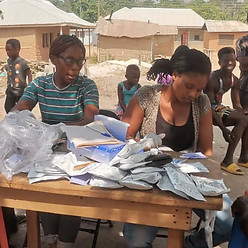
COVID-19 prevention
We are working on empowing people in the community to freely educate people on proper handwashing techniques and coronavirus prevention. Many communites have only one public toilet in the community.

Young People Living With HIV
In Ghana, approx. 1.6% of the population infected with HIV, the majority of those infected are men who have sex with men or female sex workers, this leads to a huge stigma of the infected and an exclusion from society. Among those infected in Ghana are also many young people. These young people live in constant ignorance about their risk of infecting others and ignorance about how to best take care of themselves. YPLHIVs is a project focusing on young people in Ghana who are testing positive for HIV. These young people are often stigmatized and live further with poor access to treatment. This exclusion and lack of treatment mean that young people are at increased risk of other infectious diseases and inhuman living conditions.
The project aims to teach young people infected with HIV in the disease, in addition, the young people get lunch on attendance and in collaboration with health professionals routine health care, treatment, and medication. Quarterly food donation and healthy eating are also provided to remind young people how important a healthy diet is in maintaining a healthy immune system. In the event that young people are exposed to stigma and abuse, we exercise legal support as far as possible. Unfortunately, we also experience children who are infected with HIV, this is primarily from their mother during birth, many of these children often lose their parents to AIDS early and therefore become orphans at a very early age. For this sub-group, we have a strong focus on help with schooling.
The project is currently located in northern Ghana, where the level of information about the infectious disease is very sparse and therefore an increased stigma and poor treatment are seen. The project is implemented in collaboration with local health professionals and is carried out by local staff in Ghana with many years of experience in the field of HIV. We carry out an ongoing evaluation in relation to the context and observations in society to meet the needs of young people living with HIV.

Testing for Sexually transmitted diseases
Free HIV, hepatitis B and Syphilis test
STIs are spread predominantly by sexual contact, including vaginal, anal and oral sex. Some STIs can also be transmitted from mother-to-child during pregnancy, childbirth and breastfeeding.
A person can have an STI without showing symptoms of disease, therefor testing is really important.
You can prevent Sexually transmitted diseases by correctly and consistently using condoms. Condoms also protect against unintended pregnancy in mutually consented sexual relationships.
Saving arm foundation is donating condoms, to prevent Sexually transmitted diseases. Saving arm foundation is also giving free rapid dual HIV/syphilis test whereby a person can be tested for HIV and syphilis from a single finger-stick.
Health testing
SAF staff are doing free health screening for Blood Pressure and Glucose testing.


Blood pressure
Glucose testing
Your blood pressure is recorded as two numbers:
-
Systolic blood pressure (the first number) – indicates how much pressure your blood is exerting against your artery walls when the heart beats.
-
Diastolic blood pressure (the second number) – indicates how much pressure your blood is exerting against your artery walls while the heart is resting between beats.
P-Glucose is the concentration of glucose (sugar) in the blood, also called "blood sugar" or the blood sugar level.
The body regulates the level of glucose in the blood with the help of various hormones. In addition, it also depends on the carbohydrate intake via the diet and on the function of the pancreas. After meals or liquids with a lot of carbohydrates, glucose levels rise more or less quickly, depending on what food and/or drink is consumed.
The pancreas produces insulin, which is necessary for the body's cells to absorb glucose, because the cells use glucose as energy.
